August 11, 2025
2 min read
Key takeaways:
- Injectable dermal fillers can function as vital gender-affirming care for transgender people.
- Data suggest patients seek out dermatologic or aesthetic procedures for self-esteem, mental health and safety.
Transgender people who seek dermatolgic treatments such as Botox, injectable fillers or laser therapy often do so as components of gender-affirming care and to improve their self-esteem, survey data show.
The study, published in the Journal of Drugs in Dermatology, suggests that the full scope of gender-affirming care should include access to dermatologic or aesthetic procedures not just to help a person’s appearance align with their gender identity, but to improve their mental health and even their personal safety, according to Adam Friedman, MD, FAAD, professor and chair of dermatology at George Washington University School of Medicine & Health Sciences.

“These procedures, which would maybe normally be considered cosmetic, are life-altering and part of a medical process, and that is the biggest message we want to get across,” Friedman told Healio. “What is cosmetic for one is a medical and much-needed therapy for others.”

Vincent Pecora
From an emailed survey that included 2,275 respondents, Friedman, Vincent Pecora, BA, a fourth-year medical student at George Washington University School of Medicine & Health Sciences, and colleagues analyzed data from 138 adults who identified as transgender — 86 transgender men and 52 transgender women — who received dermatologic procedures including Botox, injectable fillers, laser therapy, microneedling, silicone injection and surgical fat reduction.
Among transgender respondents, 81.9% stated that personal experiences with gender dysphoria played a role in their decision to seek out dermatologic procedures; however, the data show that transgender men were more likely to seek out such care than transgender women, the researchers reported. Transgender men were similarly more likely to seek dermatologic care than transgender women for gender-affirming care, facial feminization or masculinization and for boosting self-esteem. Transgender men also were more likely to seek dermatologic care to “fit in with others,” according to survey data.
Societal pressures or expectations likely played a role in the findings, Pecora said.
“There is often this external pressure placed on transgender men to present in ways that conform to binary gender standards in order to gain both social acceptance as well as safety,” Pecora told Healio. “We also asked some of the participants what is considered, quote, ‘beautiful’ in the LGBTQ+ community. Most transgender men answered, ‘Muscular.’ This one question demonstrates that both external and internal standards of beauty create this pressure to conform to traditional expectations of masculinity — to be recognized and accepted as men.”
For both transgender men and transgender women, safety can also factor into decisions about dermatologic or aesthetic procedures, Pecora said.
“Dermatologic procedures like Botox and filler constitute crucial components of lifesaving, gender-affirming care for transgender patients,” Pecora told Healio. “They may function to improve mental health and relieve gender dysphoria for a lot of these patient populations.”
Friedman said primary care professionals and endocrinologists should consider referring patients who identify as transgender to a dermatologist to discuss treatments that could help relieve their gender dysphoria.
“I have had patients tell me that they felt uncomfortable talking about these types of procedures with a physician at an andrology center or with an endocrinologist because they feared that they were going to be judged for wanting to pursue these things,” Friedman told Healio. “We have to deconstruct the perception that these procedures are only cosmetic.”
For more information:
Adam Friedman, MD, FAAD, can be reached at ajfriedman@mfa.gwu.edu. Vincent Pecora, BA, can be reached at vpecora@gwmail.gwu.edu.










